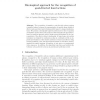Free Online Productivity Tools
i2Speak
i2Symbol
i2OCR
iTex2Img
iWeb2Print
iWeb2Shot
i2Type
iPdf2Split
iPdf2Merge
i2Bopomofo
i2Arabic
i2Style
i2Image
i2PDF
iLatex2Rtf
Sci2ools
CAIP
2009
Springer
2009
Springer
Bio-inspired Approach for the Recognition of Goal-Directed Hand Actions
The recognition of transitive, goal-directed actions requires a sensible balance between the representation of specific shape details of effector and goal object and robustness with respect to image transformations. We present a biologically-inspired architecture for the recognition of transitive actions from video sequences that integrates an appearancebased recognition approach with a simple neural mechanism for the representation of the effector-object relationship. A large degree of position invariance is obtained by nonlinear pooling in combination with an explicit representation of the relative positions of object and effector using neural population codes. The approach was tested on real videos, demonstrating successful invariant recognition of grip types on unsegmented video sequences. In addition, the algorithm reproduces and predicts the behavior action-selective neurons in parietal and prefrontal cortex.
Appearancebased Recognition Approach | CAIP 2009 | Pattern Recognition | Successful Invariant Recognition | Video Sequences |
| Added | 26 May 2010 |
| Updated | 26 May 2010 |
| Type | Conference |
| Year | 2009 |
| Where | CAIP |
| Authors | Falk Fleischer, Antonino Casile, Martin A. Giese |
Comments (0)

